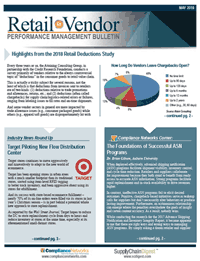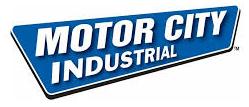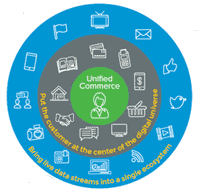Home Depot and the Arc of Today's Supply Chains
As massive as the changes we all perceive have been in business and supply chains as a result of ecommerce and all that goes with that, in many respects I think we still underestimate how different the world is becoming and where it is headed.
That's a subject for another day, other than just imagine how different suburbia and retailing will be when, I don't know, maybe 50% of US malls go under or are significantly reformulated.
With major supply chain news coming from Home Depot a couple of weeks ago, whose moves I have followed closely for many years, I thought its supply chain history over the last decade might be insightful in terms of the changes we have seen.
| GILMORE SAYS: |
Home Depot now plans to add an incredible 170 distribution new facilities across the US, so that it can reach 90% of the population now in just one day or even less.
WHAT DO YOU SAY?
Send us your
Feedback here
|
I think no other retailer other than perhaps Target stores has as interesting a history in this regard.
Sometime in Spring of 2009, I received a call from Home Depot's PR department. The home products giant was undergoing a supply chain transformation, I was told, and Home Depot would like to share the story through SCDigest.
Of course I said Yes.
Not long after that, I was in Atlanta to get the story directly from Marc Holifield, then and now head of supply chain function for Home Depot.
"We knew we were behind, and the supply chain was a competitive disadvantage for Home Depot," Holifield told me. "We looked at how quickly we could eliminate that gap and ultimately make the supply chain a true competitive advantage for us."
Home Depot's challenges, as is often the case, in general resulted from a supply chain that was built to fit one mission and set of realities, but which hadn't evolved as Home Depot's world had changed.
At the beginning and middle of Home Depot's massive growth, stores often did as much as $80 million in sales per location. But as a result of store expansion and competition, stores were doing then more like $40 million in sales. That's still a giant number, but one that changes the inventory dynamics substantially from when it was double that.
The other factor was that the focus on rapid growth in the store network ultimately slowed, as it inevitably must for all retailers. That meant the focus has to evolve, at least in part, from expansion to execution - and that meant the supply chain model had to change.
Before the transformation, about 75% of HD inventory was delivered direct to store from suppliers. That included about 60% truly direct to store, and then another 15-20% through LTL-type pool points that operated much like direct store delivery. Only 20% or so went through Home Depot DCs.
Combine that with a very store-centric ordering and replenishment process, and the results were high transportation and inventory costs, and some issues with out-of-stocks.
"The rumor when I got here was that 37,000 people at Home Depot could place orders to send inventory to the stores, and I think that was about right," Holifield said.
So, plans for a massive transformation. A network study clearly showed the opportunity to rethink Home Depot's massive network, which even with all the direct store delivery included dozens of facilities for the LTL pooling mentioned above, lumber DCs, import warehouses, and more.
"For a company with 75% direct store delivery, we sure had a big logistics infrastructure," Holifield said.
The analysis showed the opportunity to "flip the ratio totally on its head" - move to a DC-centric model in which some 75% of goods would be shipped to stores through a new generation of flow-through DCs, or what Home Depot called "Rapid Deployment Centers" (RDCs). Ultimately, Home Depot would build 20 or so RDCs.
Of course, there is nothing new about flow-through in retail distribution, although unlike most, these RDCs do nothing but flow-through. A relatively small amount of non-flow through replenishment was planned to be performed at some of the existing "carton DCs" that had been in place for some time.
"We were late, but I think we have some last mover advantage, leveraging today's technology, to actually do some leap-frogging," Holifield told me then. Initial RDCs started out as manual facilities, but significant automation was added over time.
In parallel, the company moved to a much more centralized inventory management and replenishment model, with some 70% of inventory being handled that way, versus the de-centralized model of the past.
Combined with the network changes, Home Depot hoped to increase inventory turns from around 4 in 2007 to 5 after all the changes, I will come back to that.
Complete about 2010 from the program's start in 2007, 100% of HD's US stores were served by RDCs.
 Very impressive, as I noted at the time. But it wasn't long at all before changes were needed. The catalyst was of course ecommerce. Very impressive, as I noted at the time. But it wasn't long at all before changes were needed. The catalyst was of course ecommerce.
Suddenly, a modern store-based based network would no longer suffice. In 2014, Home Depot announced it would now add to its RDC network three huge ecommerce DCs, one in its home base of Atlanta, one in the Toledo, OH area, and one on the West coast.
There were two drivers. First, more rapid delivery, with the three DCs within a two day delivery window for something like 90% of the US population. Second, despite the huge number of SKUs already stocked at Home Depot stores, with new ecommerce DCs could carry tens of thousands of additional SKUs, in "endless aisle" fashion. The three new facilities were brought live in very rapid fashion.
So that should be about the end of the story, right?
Well, not exactly.
It's still tough to make a profit at ecommerce, in part because of high picking and especially shipping costs. So when Home Depot offered buy on-line, pick-up in store with free shipping, for items stocked in the ecommerce DCs, expensive parcel and LTL modes were used to get the goods moved to a local store for pick-up - with no offsetting revenue. Not good.
Greatly summarizing, the answer was a sophisticated process of shipping in truckloads - even if not always full - from the ecom DCs to the RDCs, where they were crossdocked onto trucks already heading to the stores they serve - and where the ecom order could ride along for free. Very witty.
So, now some time for stabilization, right? Hardly.
Two weeks ago, Holifield announced new plans. Home Depot will invest $1.2 billion over the next five years to speed up delivery of goods to homes and job sites, as the rise of on-line shopping continues to reset consumer expectations.
Home Depot now plans to add an incredible 170 distribution new facilities across the US, so that it can reach 90% of the population now in just one day or even less.
The new sites will include dozens of direct fulfillment centers for next-day or same-day delivery of fast moving SKUs, as well as 100 local hubs where larger items like patio furniture and appliances will be consolidated for direct shipment to customers.
Customers "expect delivery to be free, they expect it to be timely," Holifield said. "Sometimes they want it fast, and are willing to pay for that. Sometimes they want it free, and they're willing to wait for it. We need to have the right options there." Well said.
Home Depot is also testing the use of cars and vans for lower-cost delivery of smaller orders in some markets, and expanding its network of flatbed trucks that can deliver loads of concrete and other building materials right to job sites.
So this has been a decade of incredible change for just this one company, and the key point to me is HD's commitment to stay ahead of the curve, and in Amazon fashion doing so with tremendous speed.
Two final points: Home Depot inventory turns in 2017 were 5.22, above the target set 10 years ago, even with all the additional ecommerce inventory.
Second, one of my favorite quotes in recent years on all this comes from Neil Ashe, CEO of Walmart Global ecommerce. When asked by a board member how long its ecommerce strategy would take and how much it would cost, Ashe responded: ""It will take the rest of our careers and as much money as we've got. This isn't a project. It's about the future of the company."
Indeed.
Any reaction this story of Home Depot's supply chain journey? Let us know your thoughts at the Feedback button below. |



![]()

![]()














